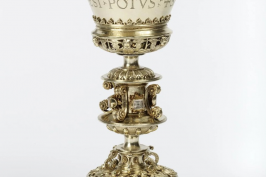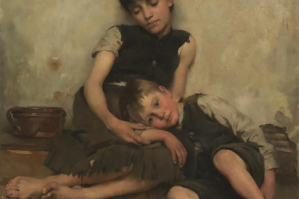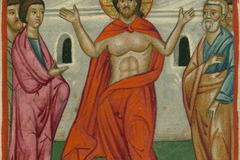Today's Gospel in Art - If the grain dies it yields a rich harvest

Harvest of the Wheat, Simon Bening, Da Costa Hours, Circa 1515 © The Morgan Library, New York
Gospel of 10th August 2020 - John 12:24-26
Jesus said to his disciples:
'I tell you, most solemnly,
unless a wheat grain falls on the ground and dies, it remains only a single grain; but if it dies, it yields a rich harvest.
Anyone who loves his life loses it;
anyone who hates his life in this world
will keep it for the eternal life.
If a man serves me, he must follow me, wherever I am, my servant will be there too. If anyone serves me, my Father will honour him.'
Reflection on the Illuminated Manuscript Page
Today we are having a closer look at this illuminated manuscript page from Ghent, circa 1515, where we see a rich harvest depicted: a woman is binding grain into sheaves, a man is threshing grain with two flails, another one is reaping grain with a sickle; in the background we see two horses, one ridden by a man, pulling a cart stacked with sheaves of grain, and further in the distance we see more fields and the village church. The beauty of looking at illuminated manuscripts is that they are part of a handwritten book of Scripture, and a feeling of reverence for the devotion to detail oozes out of these small illustrations.The colours are usually well preserved, as they are part of closed books where little or no sunlight can get in. So the freshness and vibrancy of the colours is very much the same as when these were originally produced before Gutenberg invented the printing press.
Most of these manuscripts were made in monasteries, inside the 'scriptorium', which served for study by academics as well as for the scribing of books. Four key workers were needed for building such books: the parchment maker would prepare the writing surface (usually made of animal skin); the scribe would copy the words for the book; the illuminator who decorated the pages (such as here), and the book binder who created the final product, spine and cover. As with so many of the arts, the beauty of these pieces also lies in their collaborative nature: the coming together of many artists and skills. Think of music as well, where so many artists need to work, sing, play together to create the one sound.
In today's reading Jesus uses nature, the seed, the harvest to illustrate a point. We may feel happy to be a be a wheat grain just feeling good in the sunshine. But then if we let ourselves be sown and ploughed into the damp ground, the grain loses its beauty for a while, disintegrates, ready to grow like never before. Spring time is arriving. A whole head of wheat appears with twenty, forty, sixty grains of wheat emanating… ready to be harvested. The grain had to die to itself in order to produce an abundance of wheat.
LINKS
Today's story - https://christian.art/en/daily-gospel-reading/509
Christian Art - www.christian.art





















